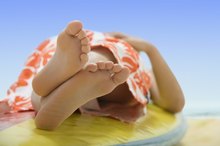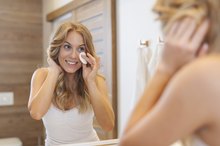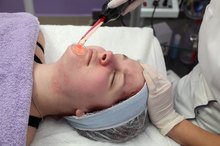What does fact checked mean?
At Healthfully, we strive to deliver objective content that is accurate and up-to-date. Our team periodically reviews articles in order to ensure content quality. The sources cited below consist of evidence from peer-reviewed journals, prominent medical organizations, academic associations, and government data.
The information contained on this site is for informational purposes only, and should not be used as a substitute for the advice of a professional health care provider. Please check with the appropriate physician regarding health questions and concerns. Although we strive to deliver accurate and up-to-date information, no guarantee to that effect is made.
Spider veins are also known as spider nevi or telangiectasia.
If you are experiencing serious medical symptoms, seek emergency treatment immediately.
In children, spider veins are usually cosmetic problems and may be asymptomatic or create mild discomfort.
The veins can occur at any age and may appear to worsen or recede, depending on cause and lifestyle factors. Parents would do well to consider the onset, frequency and duration of spider veins before obtaining medical care.
About Spider Veins
All veins carry blood from the body back to the heart.
Veins have valves which maintain the flow of blood in this direction.
When the valves weaken, blood can leak back into the vein, leading to vein swelling and discomfort.
Spider veins are relatively superficial (close to the top layer of the skin) and are much more common than varicose veins in children 2. Parents should be aware that there is a tendency for venous problems to run in families.
- All veins carry blood from the body back to the heart.
- When the valves weaken, blood can leak back into the vein, leading to vein swelling and discomfort.
Spider Veins, Girls and Health
How to Get Rid of Spider Veins on Your Nose
Learn More
There is a greater tendency for girls to have spider veins, due to fluctuating hormones which can affect the integrity of the blood vessels. However, the presence of spider veins may not indicate any other health care complication. In a study published in 1964 in the journal "Pediatrics," researchers studied 711 children ranging in age from birth to 15 years old. They found that the incidence of spider veins increased from ages two to 13 and was more prevalent in girls, but provided no other marker in otherwise healthy children.
- There is a greater tendency for girls to have spider veins, due to fluctuating hormones which can affect the integrity of the blood vessels.
Spider Veins and Skin Damage
As they begin to move independently, children can fall, and they may have a tendency to land face-down. Blows to the face can damage the skin and hurt the blood vessels, leading to the development of spider veins.
Children who receive excessive sun exposure may also develop spider veins. The American Association of Pediatrics recommends that parents dress children under six months of age in long-sleeved clothing and wide-brimmed hats in summer, and use sunscreen on a regular basis. Young children should apply sunscreen 30 minutes before heading outdoors, even if the weather is overcast. Individuals with fair skin are more susceptible to developing facial spider veins from prolonged sun exposure.
- As they begin to move independently, children can fall, and they may have a tendency to land face-down.
Spider Veins and Sinus Strain
How to Get Rid of Veins on Breasts
Learn More
Small children with developing respiratory tracts may be particularly sensitive to seasonal changes, as well as mold and mildew.
Moreover, children in childcare settings may be exposed to many different germs, leading to an ongoing series of colds. Regardless of the cause, prolonged nasal congestion can irritate the skin and weaken the blood vessels, leading to the development of spider veins around the nose and cheeks.
Spider Veins and Steroid Use
Parents may use topical steroid medications to treat various skin conditions in their children, including eczema and pruritus.
However, long-term steroid use on the face may thin the skin or lead to the development of acne rosacea, a condition where the face reddens and blood vessels in the face dilate uncontrollably.
Medications for acne rosacea may minimize skin redness without removing the spider veins. In general, parents should exercise extreme caution using steroids, seek out the lowest potency possible, and apply it sparingly.
- Parents may use topical steroid medications to treat various skin conditions in their children, including eczema and pruritus.
Spider Veins and Obesity
Obesity puts undue pressure on blood vessels and can impair their ability to function properly.
While increasing exercise is a good strategy towards combating obesity, increasing circulation can also prevent the pooling of blood in a specific region. Parents should also be cautious about sodium intake, checking nutrition labels on cereals, snacks and other prepared foods. Increased sodium levels can lead to increased bloating, as the body holds on to water to mitigate the effects of the sodium.
- Obesity puts undue pressure on blood vessels and can impair their ability to function properly.
- Increased sodium levels can lead to increased bloating, as the body holds on to water to mitigate the effects of the sodium.
Spider Vein Treatments
Parents may be lured by over-the-counter creams, but their effectiveness has not been proven in medical research. Most creams for spider veins include vitamin K (for blood clotting) and vitamin C (which can strengthen the walls of capillaries).
For whole foods sources of vitamin K, parents may look to fortified cereals, soybeans, cauliflower and leafy greens (especially spinach, kale and collards). Whole foods sources of vitamin C include kid-friendly citrus fruits such as oranges, peaches and strawberries, as well as sweet bell peppers and broccoli.
Parents seeking more immediate results may look into medical procedures, which the American Academy of Dermatology states can improve the appearance of spider veins by 80 to 90 percent.
Procedures include addressing spider veins with lasers to make them fade, or using electrical or injected solutions to cause veins to wither and heal. Keep in mind that cosmetic medical procedures which are not medically necessary may not be covered by health insurance.
- Parents may be lured by over-the-counter creams, but their effectiveness has not been proven in medical research.
- Most creams for spider veins include vitamin K (for blood clotting) and vitamin C (which can strengthen the walls of capillaries).
Related Articles
References
- Pediatrics: The Spider Nevus in Infancy and Childhood
- MayoClinic.com: Varicose Veins
- Piazza G. Varicose veins. Circulation. 2014;130(7):582-7. doi:10.1161/CIRCULATIONAHA.113.008331
- Heller JA, Evans NS. Varicose veins. Vasc Med. 2015;20(1):88-90. doi:10.1177/1358863X14566224
- U.S. Department of Health and Human Services, Office on Women's Health. Varicose veins and spider veins. Updated March 1, 2019.
- UCLA Gonda Venus Center: Symptoms and Diagnosis of Spider Veins
- WomensHealth.gov: Varicose Veins and Spider Veins Fact Sheet (2012).
Writer Bio
Sophie Bloom has been a professional writer since 2000, writing for nonprofits including the American Foundation for the Blind and The Adult Literacy Media Alliance. She received her Bachelor of Arts degree in culture and media studies from Johns Hopkins University and her Master of Science in acupuncture from Tri-State College of Acupuncture in New York City.









